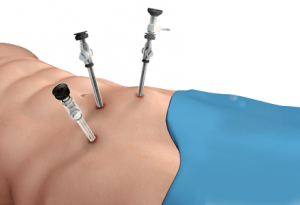Laparoscopic Surgery of the GI Tract

Laparoscopic surgery of the GI tract is a minimally invasive surgery used to treat GI diseases that do not respond to lifestyle changes or medications. A laparoscope is a thin fiber-optic device fitted with a camera and lens. Images from the camera are transmitted to a large monitor for your doctor to view the inside of your body.
Gastrointestinal (GI) diseases occur due to structural and functional abnormalities of the stomach and intestine. They can range from common digestive problems such as diarrhea, nausea and abdominal cramps to chronic disorders such as Crohn’s disease, coeliac disease, acid reflux, gallstones, irritable bowel syndrome (IBS), colitis or cancer.
Types of Laparoscopic GI Surgery
Laparoscopic GI Surgery can be any one of the following procedures:
- Appendectomy: Surgical procedure to remove an infected appendix
- Colorectal surgery: Treatment of colon and rectal conditions
- Adrenalectomy: Removal of the adrenal gland
- Bariatric surgery: Weight-loss surgery performed to control obesity
- Nissen Fundoplication: Treatment of GORD (acid reflux) symptoms
- Foregut Surgery: Surgery for the treatment of upper GI tract conditions
- Splenectomy: Surgical procedure to remove the spleen
- Retroperitoneum Surgery: Surgical treatment to remove lymph nodes for treatment of testicular cancer
- Colectomy: Surgery to remove colon
- Rectopexy: Surgery involving stitches for proper positioning of the rectum
Indications
Laparoscopic surgery of the GI tract may be used for the treatment of GI conditions such as:
- Crohn’s disease
- Diverticulitis
- Colorectal cancer
- Rectal prolapse
- Ulcerative colitis
- Chronic constipation
- Bowel incontinence
- Familial polyps
Preparing for the Surgery
Your doctor will assess your symptoms and take a medical history. Imaging tests (X-ray, MRI or CT-scan) and blood tests may be ordered. Talk to your doctor about the medicines you are taking prior to surgery. Inform your doctor if you are allergic to anesthesia. Laxatives and enemas may be used to cleanse your bowel thoroughly (depending on the GI condition). You will be given instructions to follow to ensure the bowel is clear prior to the procedure. Do not eat or drink for at least 6-8 hours prior to the procedure. Any other specific instructions will be provided by your doctor.
Laparoscopic GI Surgery Procedure
The surgery is usually performed under general anesthesia and may involve the following steps:
- You will lie on your back for the procedure.
- An IV line is started in your arm to make you feel relaxed and sleep during the procedure.
- A catheter is placed in your bladder to drain urine.
- A tube will be placed into your lungs (through the mouth) to help you breathe.
- Your heartbeat and blood pressure are closely monitored.
- A nasogastric tube will be placed to drain secretions from your stomach.
- Three to five small incisions are made in your abdomen.
- Gas is introduced into the abdomen to expand it for better visibility.
- The laparoscope is inserted and images of the internal organs are visualizedon a monitor.
- Diagnostic laparoscopy may be performed to thoroughly look into the abdomen.
- Special small surgical instruments are inserted to perform the surgery (depending on the type of GI condition).
- Care is taken to prevent damage to nearby blood vessels and nerves.
- Upon completion, the laparoscope is removed and the incisions are covered with a bandage.
- Surgery involving the rectum may require a colostomy. An opening called a stoma is created by your surgeon on the outside of your body, through which feces pass to be collected into a colostomy bag.
Recovery After the Procedure
An IV line is used to deliver pain medications and antibiotics to manage pain and infection. Initially, you will follow a liquid diet. You will be instructed to walk on the same day ofthe procedure.
At home, you will be advised to take prescribed medications. Walking multiple times a day is beneficial. You will be instructed to avoid lifting heavy weights for a few weeks.
Advantages
The advantages of laparoscopic GI surgery include:
- Smaller incision
- Minimal pain
- Reduced risk of infection
- Small surgery scars
- Blood transfusion rarely required
- Shorter recovery period
Other General Surgery Procedures
- Laparoscopic/Robotic Hernia Repair
- Laparoscopic/Robotic Cholecystectomy
- Laparoscopic/Robotic Fundoplication for Acid Reflux
- Robotic LINX Procedure for Acid Reflux
- Laparoscopic/Robotic Splenectomy
- Transoral Incisionless Fundoplication (TIF)
- Laparoscopic/Robotic Colon Resection
- Laparoscopic/Robotic Colon Resection for Diverticulitis
- Laparoscopic/Robotic Heller Myotomy for Achalasia
- Laparoscopic/Robotic Adrenalectomy
- Laparoscopic Surgery
- Laparoscopic Appendectomy
- Upper Endoscopy
- Gastrointestinal Conditions








